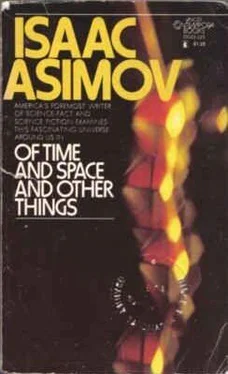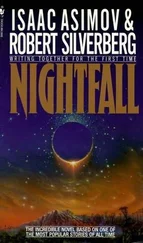Isaac Asimov - Of Time and Space and Other Things
Здесь есть возможность читать онлайн «Isaac Asimov - Of Time and Space and Other Things» весь текст электронной книги совершенно бесплатно (целиком полную версию без сокращений). В некоторых случаях можно слушать аудио, скачать через торрент в формате fb2 и присутствует краткое содержание. Год выпуска: 1972, ISBN: 1972, Издательство: Lancer Books, Жанр: Прочая научная литература, на английском языке. Описание произведения, (предисловие) а так же отзывы посетителей доступны на портале библиотеки ЛибКат.
- Название:Of Time and Space and Other Things
- Автор:
- Издательство:Lancer Books
- Жанр:
- Год:1972
- ISBN:ISBN: 0-447-33023-3
- Рейтинг книги:4 / 5. Голосов: 1
-
Избранное:Добавить в избранное
- Отзывы:
-
Ваша оценка:
- 80
- 1
- 2
- 3
- 4
- 5
Of Time and Space and Other Things: краткое содержание, описание и аннотация
Предлагаем к чтению аннотацию, описание, краткое содержание или предисловие (зависит от того, что написал сам автор книги «Of Time and Space and Other Things»). Если вы не нашли необходимую информацию о книге — напишите в комментариях, мы постараемся отыскать её.
Of Time and Space and Other Things — читать онлайн бесплатно полную книгу (весь текст) целиком
Ниже представлен текст книги, разбитый по страницам. Система сохранения места последней прочитанной страницы, позволяет с удобством читать онлайн бесплатно книгу «Of Time and Space and Other Things», без необходимости каждый раз заново искать на чём Вы остановились. Поставьте закладку, и сможете в любой момент перейти на страницу, на которой закончили чтение.
Интервал:
Закладка:
The near neighborhood of the North Celestial Pole is marked by a bright star, Polaris, also called the "pole star" and the "north star," which is only a degree or so from it and makes a small circle about it each day. The circle is so small that the star seems fixed in position day after day, year after year, and can be used as a,reference point to determine north, and therefore all other directions.
Its importance to travel in the days before the compass was incalculable.
The imaginary reference lines on the Earth can all be transferred by projection to the sky, so that the sky, like the Earth, can be covered with a gridwork of ghost nes.
There would be the "celestial equator," making up a great circle equidistant from the celestial poles; and "celestial latitude" and "celestial longitude" also.
The celestial latitude is called "declination," and is measured in degrees. The northern half of the celestial sphere ("north celestial latitude") has its declination given as a positive value; the southern half ("south celestial latitude") as a negative value. Thus, Polaris has a declina tion of roughly +89'; Pollux one of about +30'; Sirius one of about -15'; and Acrux (the brightest star of the Southern Cross) a declination of about -60'.
The celestial longitude is called "right ascension" and the sky has a prime meridian of its own that is less arbitrary than the one on Earth, one which could therefore be set and agreed upon quite early in the game.
I The plane of the Earth's orbit about the Sun cuts the celestial sphere in a great circle called the "ecliptic" (see Chapter 4). The Sun seems to move exactly along the line of the ecliptic, in other words.
Because the Earth's axis is tipped to the plane of Earth's orbit by 23.5', the two great circles of the ecliptic and the celestial equator are angled to one another by that same 23.50.
The ecliptic crosses the celestial equator at two points.
When the Sun is at either point, the day and night are equal in length (twelve hours each) all over the Earth.
Those points are therefore the "equinoxes," from Latin words meaning "equal nights."
At one of these points the Sun is moving from negative to positive declination, and that is the "vernal equinox" because it occurs on March 20 and marks the beginning of spring in the Northern Hemisphere, where most of man kind lives. At the other point the Sun is moving from positive to negative declination and that is the autumnal equinox, falling on September 23, the beginning of the northern autumn.
The point of the vernal equinox falls on a celestial meridian which is assigned a value of O' right ascension.
The celestial longitude is then measured eastward only (either in degrees or in hours) all the way around, until it returns to itself as 360' right ascension.
By locating a star through declination and right ascension one does precisely the same thing as locating a point on Earth through latitude and longitude.
An odd difference is this, though. The Earth's prime meridian is fixed through time, so that a point on the Earth's surface does not change its longitude from day to day. However, the Earth's axis makes a slow revolution once in 25,800 years, and because of this the celestial equator slowly shifts, and the points at which it crosses the ecliptic move slowly westward.
The vernal equinox moves westward, then, circling the sky every 25,800 years, so that each year the moment in time of the vernal equinox comes just a trifle sooner than it otherwise would, The moment precedes the theoretical time and the phenomenon is therefore called "the preces sion of the equinoxes."
As the vernal equinox moves westward, every point on the celestial sphere has its right ascension (measured from that vernal equinox) increase. It moves up about 1/7 of a second of arc each day, if my calculations are correct.
This system of locating points in the sky is'ealled the "Equatorial System" because it is based on the location of - the celestial equator and the celestial poles.
A second system may be established based on the observer himself. Instead of a "North Celestial Pole" based on a rotating Earth, we can establish a point directly overhead, each person on Earth having his own overhead point-although for people over a restricted area, say that of New York City, the different overhead points are practically identical.
The overhead point is the "zenith," which is a medieval misspelling of part of an Arabic phrase meaning "over head." The point directly opposite in that part of the celestial sphere which lies under the Earth is the 'nadir," a medieval misspelling of an Arabic word meaning "op posite."
The great circle that runs around the celestial sphere, equidistant from the zenith and nadir, is the "horizon," from a Greek word meaning "boundary," because to us it seems the boundary between sky and Earth (if the Earth were perfectly level, as it is at sea). This system of locating points in the sky is therefore called the "Horizon System."
The north-south great circle traveling from horizon to horizon through the zenith is the meridian. The cast-west great circle traveling from horizon to horizon through the zenith, and making a right angle with the meridian, is the 14 prime vertical."
A point in the sky can then be said to be so I many degrees (positive) above the horizon or so many degrees (negative) below the horizon, this being the "altitude."
Once that is determined, the exact point in the sky can be located by measuring on that altitude the number of degrees westward from the southern half of the meridian.
At least astronomers do that. Navigators and surveyors measure the number of -degrees eastward from the north end of the meridian. (In both cases the direction of meas ure is clockwise.)
The number of degrees west of the southern edge of the meridian (or east of the northern edce, depending on the system used) is the azimuth. The word is a less corrupt form of the Arabic expression from which "zenith" also comes.
If you set north as having an azimuth of O', then east has an azimuth of 90', south an azimuth of 180', and west an azimuth of 270'. Instead of boxing the compass with outlandish names you can plot direction by degrees.
And as for myseff?
Why, I have an azimuth of isaac. Naturally.
4. The Heavenly Zoo
On July 20, 1963 there was a total eclipse of the Sun, visible in parts of Maine, but not quite visible in its total aspect from my house. In order to see the total eclipse I would have had to drive two hundred miles, take a chance on clouds, then drive back two hundred miles, braving the traffic congestion produced by thousands of other New Englanders with the same notion.
I decided not to (as it happened, clouds interfered with seeing, so it was just as well) and caught fugitive glimpses of an eclipse that was only 95 per cent total, from my backyard. However, the difference between a 95 per cent eclipse and a 100 per cent eclipse is the difference between a notion of water and an ocean of water, so I did not feel very overwhelmed by what I saw.
V-/bat makes a total eclipse so remarkable is the sheer astronomical accident that the Moon fits so snugly over the Sun. The Moon is just large enougb. to cover the Sun completely (at times) so that a temporary night falls and the stars spring out. And it is just small enough so that during the Sun's obscuration, the corona, especially the brighter parts near the body of the Sun, is completely visible.
The apparent size of the Sun and Moon depends upon both their actual size and their distance from us. The diameter of the Moon is 2160 miles while that of, the Sun is 864,000 miles. The ratio of the diameter of the Sun to that of the Moon is 864,000/2160 or 400. In other words, if both were at the same distance from us, the Sun would appear to be 400 times as broad as the Moon.
Читать дальшеИнтервал:
Закладка:
Похожие книги на «Of Time and Space and Other Things»
Представляем Вашему вниманию похожие книги на «Of Time and Space and Other Things» списком для выбора. Мы отобрали схожую по названию и смыслу литературу в надежде предоставить читателям больше вариантов отыскать новые, интересные, ещё непрочитанные произведения.
Обсуждение, отзывы о книге «Of Time and Space and Other Things» и просто собственные мнения читателей. Оставьте ваши комментарии, напишите, что Вы думаете о произведении, его смысле или главных героях. Укажите что конкретно понравилось, а что нет, и почему Вы так считаете.












